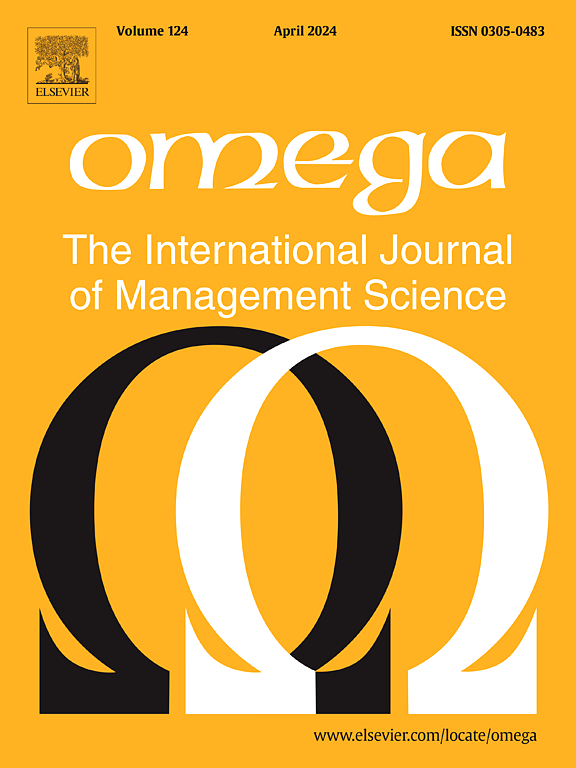The role of hubs and economies of scale in network expansion
IF 6.7
2区 管理学
Q1 MANAGEMENT
Omega-international Journal of Management Science
Pub Date : 2024-11-12
DOI:10.1016/j.omega.2024.103220
引用次数: 0
Abstract
Freight distribution often operates on the basis of consolidation, which is achieved through the use of hub facilities that allow for economies of scale. Freight networks need to be expanded to meet future demand, to cater for new markets, and to accommodate trends in global supply chains, for which strategic decisions need to be made. These decisions mainly entail the number and location of new hubs to be established. As network expansions require significant capital, striking a balance between the benefits afforded by the new hubs and the expansion costs is crucial. This paper investigates a hub network expansion problem where the configuration of the resulting network is determined by the trade-off between the fixed costs of locating new hubs and new links, as well as routing costs of shipping commodities, and the cost reductions achieved through economies of scale, without imposing a predetermined network structure. This paper also describes a mixed integer programming formulation of the problem and a Benders decomposition algorithm that uses several enhancement techniques to efficiently solve the model to optimality. The application of the algorithm on a real-life case study arising in the expansion of the Indonesian freight transport network yields several managerial insights. In particular, expanding the network with additional hubs and links can yield substantial cost savings, averaging at 47.6%, although at the expense of an increase in the length of the commodity paths. Failing to operate the network at the selected level of economies of scale can result in an increase in the routing costs by up to 58.8%. Expanding the network with no additional hubs leads to a rise in total costs of up to 20.9%. Finally, lower economies of scale leads to an increase in the length of commodity paths, with the routing cost being identified as the most sensitive parameter.
枢纽和规模经济在网络扩展中的作用
货运分销通常以整合为基础,通过利用枢纽设施实现规模经济。货运网络需要扩大,以满足未来的需求,迎合新的市场,并适应全球供应链的发展趋势,为此需要做出战略决策。这些决定主要涉及要建立的新枢纽的数量和位置。由于网络扩张需要大量资金,因此在新枢纽带来的效益与扩张成本之间取得平衡至关重要。本文研究的是一个枢纽网络扩展问题,在这个问题中,所产生的网络配置是由确定新枢纽和新链接位置的固定成本以及运输商品的路由成本与通过规模经济降低成本之间的权衡决定的,而不强加一个预定的网络结构。本文还介绍了该问题的混合整数编程公式和一种本德斯分解算法,该算法采用了多种增强技术,可高效地求解该模型,使其达到最佳状态。将该算法应用于印尼货运网络扩展过程中出现的一个实际案例研究中,可获得若干管理启示。特别是,通过增加枢纽和连接点来扩展网络可以节省大量成本,平均节省 47.6%,但代价是增加商品路径的长度。如果不按选定的规模经济水平运营网络,路由成本最多会增加 58.8%。在不增加枢纽的情况下扩大网络,总成本最多会增加 20.9%。最后,较低的规模经济导致商品路径长度增加,路由成本被确定为最敏感的参数。
本文章由计算机程序翻译,如有差异,请以英文原文为准。
求助全文
约1分钟内获得全文
求助全文
来源期刊

Omega-international Journal of Management Science
管理科学-运筹学与管理科学
CiteScore
13.80
自引率
11.60%
发文量
130
审稿时长
56 days
期刊介绍:
Omega reports on developments in management, including the latest research results and applications. Original contributions and review articles describe the state of the art in specific fields or functions of management, while there are shorter critical assessments of particular management techniques. Other features of the journal are the "Memoranda" section for short communications and "Feedback", a correspondence column. Omega is both stimulating reading and an important source for practising managers, specialists in management services, operational research workers and management scientists, management consultants, academics, students and research personnel throughout the world. The material published is of high quality and relevance, written in a manner which makes it accessible to all of this wide-ranging readership. Preference will be given to papers with implications to the practice of management. Submissions of purely theoretical papers are discouraged. The review of material for publication in the journal reflects this aim.
 求助内容:
求助内容: 应助结果提醒方式:
应助结果提醒方式:


